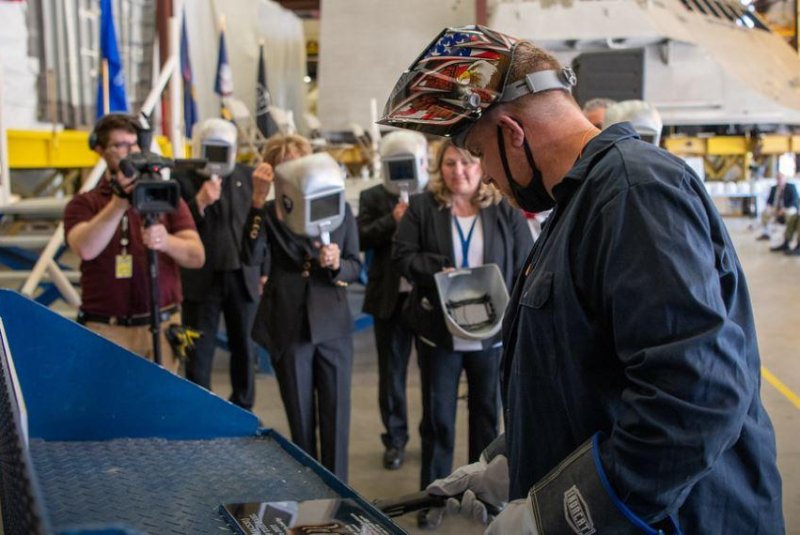In a ceremony on Wednesday, a welder at Fincanteri Mariette Marine in Marinette, Wis., welded the initials of ship's sponsor into the keel of the future USS Cleveland. Photo courtesy of
Team Freedom/Lockheed Martin/Flickr
June 18 (UPI) -- Construction of the U.S. Navy's 31st littoral combat ship, to be named USS Cleveland, began this week with a keel-laying ceremony in Marinette, Wis.
The ship, designed by Lockheed Martin, will be built at subsidiary Fincantieri Marinette Marine in Marinette, Wis., with plans for its formal christening in 2022 and delivery to the Navy, and commissioning, in 2023.
The USS Cleveland will then be homeported in Mayport, Fla., with Littoral Combat Ship Squadron Two.
Robyn Modly, wife of former Navy Secretary Thomas Modly, was the ship's sponsor in Wednesday's ceremony. A welder engraved her initials into the keel, in a traditional start to construction of a warship.
The future USS Cleveland is a Freedom-class littoral combat ship, capable of operating in relatively shallow littoral, or near-shore, water.
Heavily armed but relatively small at 378 feet in length, Freedom-class LCS vessels carry one MH-60 helicopter and are armed with a Mk 110 57 mm gun, RIM-116 Rolling Airframe Surface-to-Air Missiles, Naval Strike and Hellfire missiles, a 150 kw high-energy laser and .50-caliber machine guns.
The Freedom-class has, however, become notorious for design and engineering problems.
A U.S. Navy task force identified 32 reliability issues in its fleet of littoral combat ships, the commander of Naval Surface Forces said last week.
"We've been working a lot of issues on LCS," Vice Adm. Roy Kitchener said in a telephone conference on June 7. "One of the biggest factors we've seen [is] the downtime that was created [by] unreliable parts or parts on critical systems that were failing."
The Freedom class has seen repeated breakdowns of its ships because of transmission failures caused by ineffective engineering of combining gears, which connect engines, according to the task force.
Three ships in the class -- the USS Milwaukee, the USS Fort Worth and the initial USS Freedom -- have experienced breakdowns leaving them unusable. In January, the Navy stopped accepting new ships until a fix is found.
Kitchener cited 32 "key reliability issues" across the 23 ships of the Freedom and Independence variants of littoral combat ships, largely concentrated on failures in water-jet propulsion systems and power plants, including engines, engine mounts and fuel lines.
The task force addressed reliability, sustainability, lethality and force generation of the ships, and determined which improvements would have "the biggest impact with the biggest return on investment," Kitchener said.















